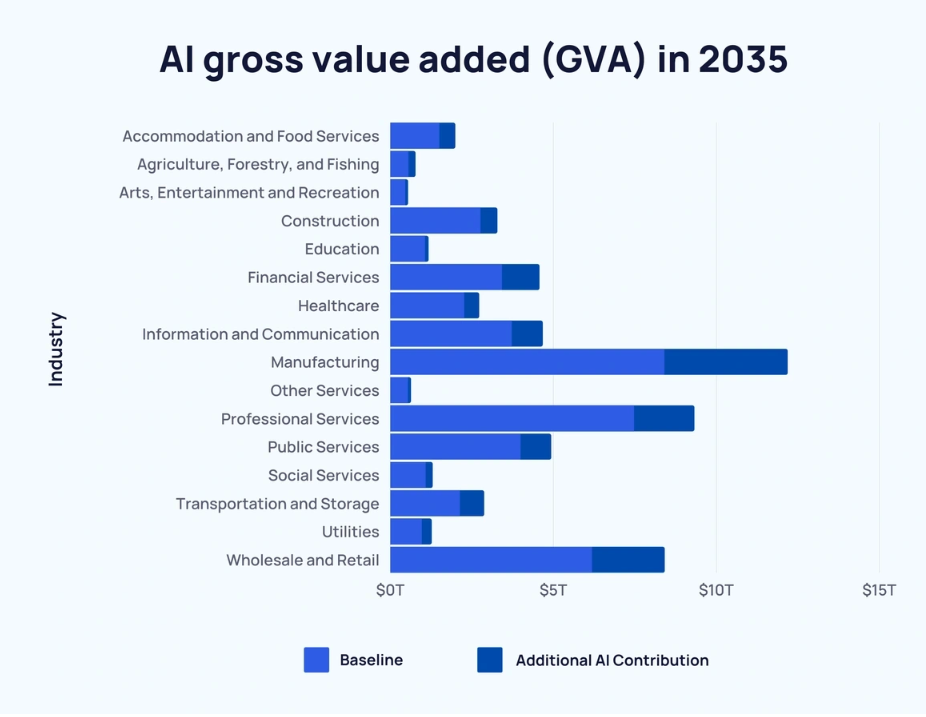The rise of generative AI continues to drive a paradigm shift across industries, compelling businesses to adapt swiftly to harness its potential. Recent statistics provided by Scale in 2024 highlight the rapid integration of AI technologies into various sectors, revealing a significant trend: companies are increasingly embedding AI into their core strategies to maintain competitiveness and spur innovation.
Overview: The Surge of AI in Modern Business
Businesses today find themselves at a pivotal moment in the AI revolution. With 79% of professionals reporting some exposure to generative AI tools, the technology’s impact is widespread, affecting various sectors from technology to healthcare. This adoption is not just limited to professional environments—many also utilize these tools outside of work, indicating a growing familiarity and comfort with AI technologies across the board.

Source: Accenture
The chart above shows the projected gross value added (GVA) by AI across industries by 2035. Manufacturing is expected to see the largest boost, followed by information and communication, and financial services. Healthcare, professional services, and retail are also projected to benefit significantly. These projections highlight AI’s transformative potential in driving economic growth across various sectors.
Industry Analysis: AI Adoption Trends 2023-2024
The key findings from the year show a dynamic shift in the perception and integration of AI:
- Strategy Transformation: 18% of organizations in 2024 report that generative AI has prompted a reassessment and creation of new AI strategies, up from 12% in 2023.
- Investment Surge: Consistently, 72% of businesses plan to enhance their investment in proprietary AI solutions over the next three years.
- Critical Importance: The belief in AI’s critical role has grown, with 74% of companies in 2024 considering AI as vital compared to 69% the previous year.

Source: Scale
Overcoming AI Implementation Challenges
As businesses navigate the complexities of AI integration, they often encounter not just technical challenges but also deep-seated fears and misconceptions about the technology. These fears, though not always well-founded, can stymie progress and innovation. It is crucial for organizations to address these concerns directly and focus on the positive aspects of AI, fostering a culture that embraces change rather than fearing it.
Businesses often stumble over several hurdles:
- Unclear Objectives and the Fear of Change A primary reason for the failure of AI projects is the lack of clear, actionable objectives. Without a well-defined problem, AI initiatives can become unfocused, consuming resources without delivering meaningful outcomes. The fear of change also plays a significant role here; stakeholders may resist new technologies, worrying about the disruption AI might cause. To overcome these challenges, businesses must set precise, measurable goals for their AI projects and manage the change process carefully, ensuring all stakeholders understand the benefits and new workflows introduced by AI.
- Data Quality Issues: Garbage In, Garbage Out The old adage “garbage in, garbage out” is particularly pertinent in the context of AI. The quality of the output produced by AI systems is directly related to the quality of the data fed into them. Poor data governance can result in inaccurate, biased AI models that do more harm than good. Businesses must invest in robust data management systems and practices to ensure high-quality, clean, and relevant data is available for their AI systems.
- Inadequate Collaboration: Breaking Down Silos AI implementation is not just a job for tech teams; it requires input and cooperation across the entire organization. Inadequate collaboration between departments such as IT, data science, operations, and business units can lead to AI projects that are misaligned with business needs or fail to scale across the organization. Promoting a culture of collaboration and openness is essential, as it encourages sharing of insights and expertise, which in turn enhances the effectiveness of AI solutions.
- The Paradox of AI: Potent Yet Intimidating While AI can streamline operations, predict trends, enhance customer experiences, and optimize decision-making, there’s often a daunting aspect to its adoption. The complexity of AI technologies and the rapid pace of advancements can intimidate businesses, particularly those without a strong tech foundation. The fear of the unknown, including AI’s potential to replace human jobs, can create resistance among employees and management alike. Education and transparent communication about AI’s role and benefits can help demystify the technology and reduce fears, clearing the path to its successful adoption.
Understanding and addressing these challenges is crucial for businesses that aim to leverage AI effectively. It’s important to recognize that while AI is not a panacea, it offers considerable benefits across various functions if implemented thoughtfully. The journey towards AI integration should be viewed as a strategic evolution, one that requires patience, persistence, and proactive management. Businesses that embrace AI with a clear strategy and an open mindset will likely find themselves at the forefront of their industries.

Source: Scale
AI Deployment: How to Build a Successful AI Strategy
Crafting a successful AI strategy is crucial for companies aiming to harness the transformative power of artificial intelligence. This process involves careful planning, clear goal setting, and a deep understanding of both the technological capabilities and the business’s unique needs. Here’s a step-by-step guide to help businesses build an AI strategy that not only meets but exceeds their operational goals, making the journey both engaging and beneficial for clients and readers.
- Identifying AI Opportunities: Define the Problem Start with the basics: clearly define the problem you are trying to solve with AI. What specific business challenges or opportunities do you aim to address? This step is about moving beyond the hype of AI and focusing on real, tangible areas where AI can have a measurable impact. Whether it’s improving customer satisfaction, optimizing supply chains, or enhancing product recommendations, ensure the problem is well understood and aligned with your strategic objectives.
- Visionary Leadership: Crafting a Future with AI Creating a compelling vision for what AI can achieve in your organization is crucial. This vision should include not only the end goals but also the impact on various stakeholders, including employees, customers, and partners. A clear, inspiring vision will help rally the organization around the AI initiatives and provide a clear benchmark for success.
- Evaluating Readiness: Is Your Organization AI-Ready? Evaluate your organization’s readiness to implement AI by reviewing existing infrastructure, data maturity, and internal skills. Do you have the necessary data architecture? Are your IT systems equipped to handle new AI applications? Is there enough talent within the organization, or is there a need to hire or train personnel? Understanding these elements will help you pinpoint readiness gaps and plan accordingly.
- Ethical AI Usage: Planning for Data and Ethics Data is the lifeblood of AI. Develop a comprehensive data strategy that ensures quality data collection, management, and governance. It’s equally important to consider the ethical implications of AI deployment. Establish guidelines that uphold fairness, transparency, and accountability to prevent bias and protect privacy, reinforcing trust in AI systems.
- Incremental Implementation: The Benefits of a Phased Approach AI implementation doesn’t have to be an all-in-one leap. A phased approach allows for the gradual integration of AI technologies, enabling businesses to manage risks and learn from each phase. Start with pilot projects that can provide quick wins and scale up based on those successes. This method reduces the overall risk and provides tangible evidence of AI’s potential to stakeholders.
- Cultivating Collaboration: Encouraging Team Synergy AI initiatives thrive on collaboration across different parts of the organization. Encourage teams from IT, data science, business units, and customer service to work together to identify use cases, share insights, and drive innovation. This cross-pollination of ideas and expertise is vital for creating AI solutions that are practical, scalable, and deeply integrated into the business.
- Continuous Improvement: Monitoring and Adapting AI Systems Once your AI systems are in place, it’s critical to monitor their performance and impact continuously. Set up mechanisms to track effectiveness against defined KPIs and use the insights gained to refine and improve your AI strategies. Regular evaluation helps identify issues early, allowing for timely adjustments that keep your AI initiatives aligned with business goals.
- Stay Informed on AI Trends AI is a rapidly evolving field. Keeping abreast of the latest technologies, tools, and strategies in the AI space can provide a competitive edge. Regularly attending seminars, participating in workshops, and engaging with the AI community can lead to insights that refine your AI strategy and implementation.
Conclusion: The Imperative of AI Integration for Business Viability
The integration of AI is no longer a futuristic ambition but a present-day necessity. The data and trends from 2023 to 2024 indicate that businesses are increasingly recognizing this fact, moving rapidly to not only adopt AI but to embed it deeply within their strategic frameworks. For companies still on the fence, the message is clear: the time to act is now. AI offers a transformative potential that can redefine industries, making it essential for survival and success in a rapidly evolving business landscape.
Businesses must approach AI adoption with a strategic mindset, addressing potential challenges head-on and leveraging AI’s capabilities to drive significant business value. The journey is complex but, with the right strategy and execution, immensely rewarding.





